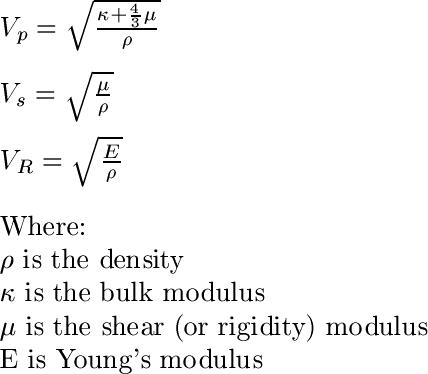Date: Thu Mar 10 23:36:20 2005
Posted By: David Dunbar, Staff, Geophysics, GeoCenter, Inc.
Area of science: Earth Sciences
ID: 1110303251.Es
Message:
Merry,
The main factors that determine seismic wave velocity are the density and
structural strength of the Earth. These vary with depth, location and
composition. Other factors include the frequency of the seismic energy and
the number, orientation and shape of cracks or other voids in the ground.
 Energy in seismic waves travels in several modes. The compression or P wave
travels through the body of the Earth. It is the fastest wave and is the
same as sound waves in air or water. Particle motion for a P wave is a
compression / expansion motion. The shear or S wave also travels through
the body of the Earth. The S wave typically travels about half the speed of
the P wave. Particle motion for an S wave is a twisting motion. S waves do
not travel in air or water.
Energy in seismic waves travels in several modes. The compression or P wave
travels through the body of the Earth. It is the fastest wave and is the
same as sound waves in air or water. Particle motion for a P wave is a
compression / expansion motion. The shear or S wave also travels through
the body of the Earth. The S wave typically travels about half the speed of
the P wave. Particle motion for an S wave is a twisting motion. S waves do
not travel in air or water.
There are two waves that travel along the surface called Rayleigh and Love
waves after the scientists who first described them. Both are slower than S
waves. Particle motion in Rayleigh waves is a vertical ellipse. The slowest
waves, Love waves, donít exist everywhere. They require a shear wave
velocity profile with a low velocity layer at the surface and a much faster
layer just under it. The particle motion is horizontal side to side. The
equation describing the velocity of Love waves is quite complex. Both
Rayleigh and Love waves can be dispersive, i.e. the velocity depends on
frequency.
In oil and gas exploration the P waves are the most often used.
Historically S waves were mostly ignored and Rayleigh and Love waves were
considered a nuisance. In the last few years it has been shown that S waves
can provide useful information to compliment the P waves. Surveys are being
designed to record both P and S waves at the same time. This requires three
axis detectors. Processing combined surveys requires a means of identifying
the P and S wave reflections from the same structures. This is still
something of a black art. Surveys are designed in an attempt to minimize
Rayleigh and Love waves, collectively called ground roll. Ground roll
frequently is much stronger than the P and S waves.
Earthquake studies try to use all four waves. The distances between
earthquakes and recording stations are generally long enough that the waves
are separated enough to cleanly identify each. The dispersive Rayleigh and
Love waves can help constrain the velocity structure near the surface.
The frequency range of useful energy in earthquake studies is quite low. A
frequency of 250 Hz is considered quite high. On the low end a frequency of
1 cycle per minute is fairly commonly recorded. In normal oil and gas
exploration the frequency range is from 5 to 250 Hz. Engineering studies
for construction projects and borehole studies for oil and gas wells may
reach 2000 Hz.
Structural strength of rock is described in terms the elastic constants of
the rock. The equations describing P, S and R velocities assume the modulii
are constants over distances smaller than the wavelength of the seismic
wave. This works fairly well for earthquake and oil and gas work. The
frequencies are low enough that the wavelengths are tens of meters to many
kilometers long. This is not true for engineering and borehole studies. The
assumption also breaks down in regions where there is a regional
orientation of cracks or voids in the ground. The S waves are especially
sensitive to this.
David
Current Queue |
Current Queue for Earth Sciences |
Earth Sciences archives
Try the links in the MadSci Library for more information on Earth Sciences.
MadSci Home | Information |
Search |
Random Knowledge Generator |
MadSci Archives |
Mad Library | MAD Labs |
MAD FAQs |
Ask a ? |
Join Us! |
Help Support MadSci
MadSci Network,
webadmin@madsci.org
© 1995-2005. All rights reserved.
 Energy in seismic waves travels in several modes. The compression or P wave
travels through the body of the Earth. It is the fastest wave and is the
same as sound waves in air or water. Particle motion for a P wave is a
compression / expansion motion. The shear or S wave also travels through
the body of the Earth. The S wave typically travels about half the speed of
the P wave. Particle motion for an S wave is a twisting motion. S waves do
not travel in air or water.
Energy in seismic waves travels in several modes. The compression or P wave
travels through the body of the Earth. It is the fastest wave and is the
same as sound waves in air or water. Particle motion for a P wave is a
compression / expansion motion. The shear or S wave also travels through
the body of the Earth. The S wave typically travels about half the speed of
the P wave. Particle motion for an S wave is a twisting motion. S waves do
not travel in air or water.